4. Tiger Majesty - new from Puzzle Lab
An in-depth review of Tiger Majesty, some background information about the puzzle lab company and the artist, and digressions about poetry and tigers (about 4000 words; 24 pictures)
laser-cut Puzzle Lab cutting designer – Andrew Azzopardi
artist - Ella Mazur
357 pieces 15”x10½” (36x27 cm) UV-printed on 5mm maple-veneered 3 ply
[Note: other than being a local customer I have no affiliation with Puzzle Lab.]
Preamble digression
I had to get that out of the way. You may have been thinking of those very words when you saw the picture. I know they immediately sprang to my mind when I first saw the artwork for this puzzle. These are perhaps the most famous opening lines of any poem in the English language.
I don’t know what schooling is like today, but back in my day (i.e., about 55 years ago) the poem (or at least, this part of it) was probably memorized by every high-school student in every English-speaking country. I have described my awesome power of forgetfulness in previous posts but even I can remember that opening verse. Better yet, I can remember the powerful twist in the final verse, which repeats this one but finishes with “Dare frame thy fearful symmetry?”
These are the opening lines to William Blake’s poem The Tyger. According to Wikipedia, Blake (1757-1827) was “largely unrecognized during his life, [but is] now considered a seminal figure in the history of the poetry and visual art of the Romantic Age.” And this is by far his most famous poem, with the possible exception of his Jerusalem (and that, only because it got made into the lyrics of a patriotic English hymn: “And did those feet in ancient time / Walk upon England’s mountains green.”)
For more information about William Blake Wikipedia is a good place to start. For the full poem and a brief English Lit professor style analysis of it I suggest here or here.
Introduction
I pre-ordered this puzzle as soon as Puzzle Lab first gave its regular customers a sneak-peek at the artwork. Actually, I had already decided to order it even before I saw the image.
Puzzle Lab is in Victoria, the city where I live, and I had already bought and assembled five of their puzzles before this one – the most of any brand I have bought. Back in February I had assembled their challenging limited edition lovebirds puzzle that used the classic “Victorian” style of cutting as well as an irregular outline and drop-out voids, and I absolutely loved it!
Most of their puzzles use a mathematically-derived parametric design (see below, under puzzle lab) as the basis for their cutting. It is not that I don’t like that style, but I do have an affinity for wood puzzles’ hand-cutting and human-design heritage, and I have dropped more than a few hints with the company that I would like to see more in this style.
This dramatic artwork reinforced my eagerness to get and assemble the new puzzle as soon as I could. When I got an email on Tuesday that my puzzle was ready for pick-up I immediately went down to their workshop to get it. It turns out mine was the first one delivered to a customer. Tinka (one of puzzle lab’s co-founders) asked that I not publish this review until after the puzzle was first made available to buy from their store, yesterday. But I began the puzzle later the same day that I picked it up.
Opening the puzzle and assembly walk-through
As with all of their puzzles, Tiger Majesty comes in a compact attractive matte-black magnetic-closure box. It includes a cloth bag to hold the pieces within the box for future safe storage and an information card about the artist, Ella Mazur.
Upon dumping the pieces out on my puzzle board my first impression was how mild the campfire smell was from the freshly-lasered puzzle. My second was how bright the orange and white tiger-face colours are on the pieces compared to the dark jungle context pieces. Then I noted how sharp and crisp the pen & ink drawing in the image looked, and how delicate the shading was. Great printing!
When I began sorting I noticed that most of the connectors were perfect little circles of varying sizes rather than a variety of shapes and sizes. I also noticed that there seemed to be very few straight-edge pieces, and there were no whimsies.
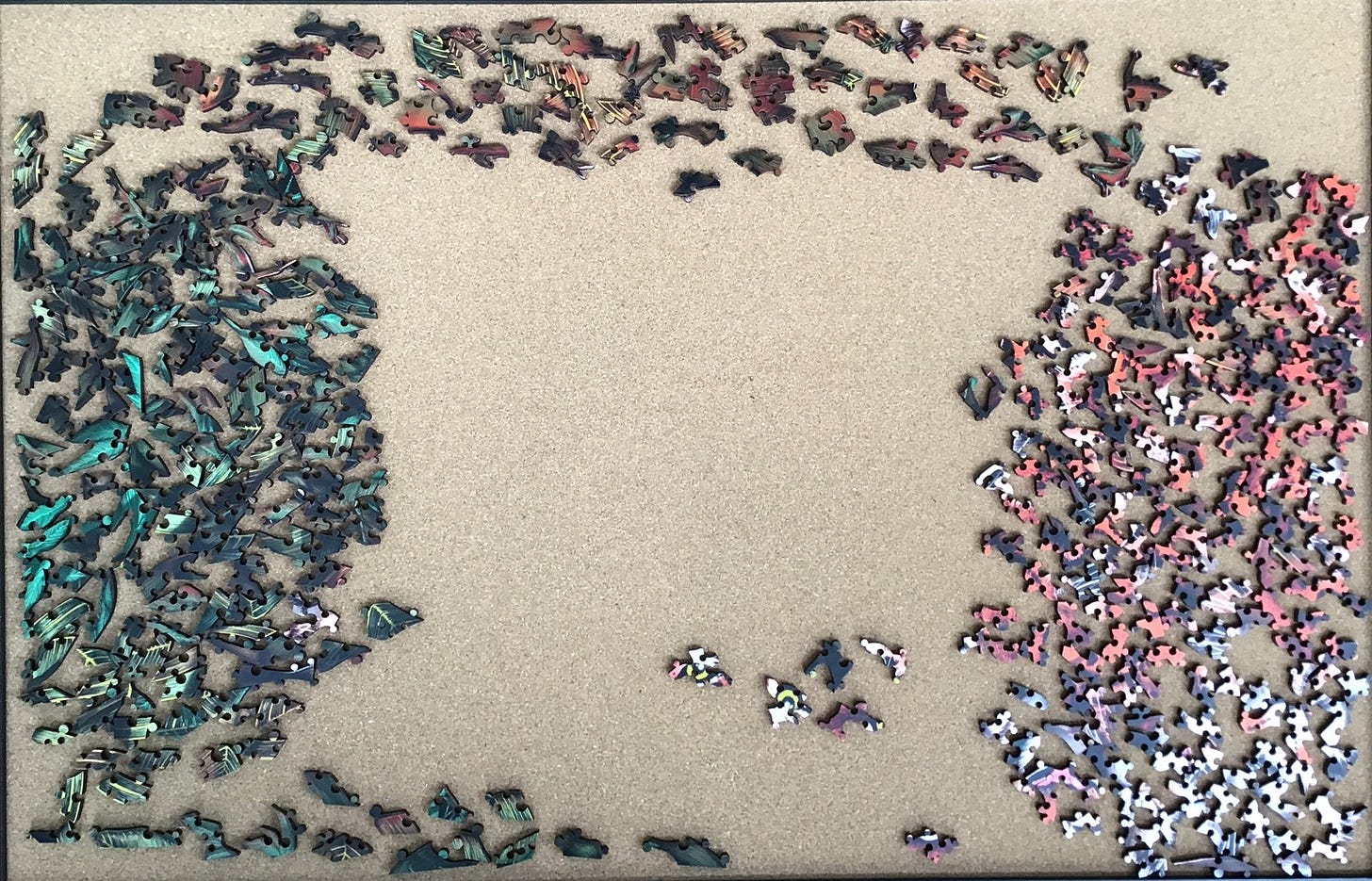
Although I purposely avoided studying the picture to plan my assembly strategy the image was still fresh in my mind. I knew it was a big tiger face surrounded by green foliage. Since beginning the puzzle with the edges seemed to be out of the question I knew that I would need to assemble it inside out and with clusters of target-of-opportunity pieces.
When I picked up the puzzle, Andrew, the puzzle’s designer, mentioned that the colour-line cutting was in the foliage part of the puzzle and that the tiger’s face had a different style of cutting. (This wasn’t a spoiler; this is also mentioned on the posting for this puzzle on their website.) I could see this in the pieces before me. The orange/white/black ones tended to be small or more complex shapes, and the foliage ones seemed to be bigger and longer.
I expected that the eyes would be my starting place and the puzzle would grow out from there. Instead, the few pieces with the tiger’s pink nose turned out to be the place from which it grew. The pieces with pink led to the white muzzle, pieces with whiskers, and the distinctive orange texture going up the nose.
Getting the eyes in place (and onto the correct sides of the face!) started to bring the tiger to life. It was at this stage that I recognized that the tiger’s face isn’t actually symmetrical, even though that is the overall effect. I guess that nature doesn’t work the way that people (including William Blake) see things.
For the whole rest of the assembly, and even now since I haven’t disassembled it as I write this, the tiger stares directly at me. He (or is it a she?) doesn’t look threatening. She doesn’t look judgmental. The word “cuddly” never came to mind. But the tiger was always watching me; challenging me to complete the puzzle. (In my mind I began to think of the tiger as embodying Andrew’s spirit, as the designer posing a personal challenge to me as the assembler.)
It was also at about this point that I began thinking of this as being two puzzles in one. There is a tiger puzzle and a jungle puzzle. The orange/white/black pieces were beginning to dwindle away, while the disorganized cluster of foliage pieces that I was ignoring at that stage seemed to be getting bigger.
Getting both ears attached seemed like an accomplishment. That really gave my tiger more personality.
Completing my tiger really did indeed yield a feeling of accomplishment just like completing a puzzle.
I don’t keep track of the time I spend puzzling but getting to this stage might have been about seven or eight hours. (Hey, I’m retired. I’m in no hurry to get a puzzle completed.) I knew that there were more and different challenges to come, that would probably take even longer to assemble, I felt like I had successfully met the warm-up challenge from Andrew and he had set me up for his next challenge to come.
The next step was to re-sort the remaining pieces and begin the sequel.
I had been thinking of the foliage pieces as all being dark and dreary. But as I started assembling them I realized that there were some distinctively coloured islands that could be built. More importantly, I found that there were bright yellow veins in many of the (philodendron?) leaves, other leaves (or parts thereof) were bright green, and there are bright red highlights on some leaves. This jungle forest was more colourful than I thought. It was only the vivid orange and white of the tiger that had made this part of the puzzle seem drab by comparison.
There are significant benefits of building clusters (or islands) of pieces. Making a cluster not only means that you are making progress but it also gives you a better opportunity to find where to attach them to the growing puzzle, and being sure that you put the pieces are in their right place. Also, it feels so satisfying to make a big chunk of progress when you do so.
For me, placement of pieces in all puzzles tends not to come steadily. There are long gaps when I can’t find anything, but when I do I tend to be able to place several pieces in fairly quick succession. One result of this phenomenon is that after one of those long gaps when I am able to put a piece in place I feel a rise in optimism that it will soon lead to a second, then a third, etc., because that is the way it so often works out. Is it that optimism that causes the follow-up successes, or is it all just a coincidence that it happens this way?
As you can see on the bottom left of the above picture, a couple of islands make long sweeping outside curves. But there are no pieces with matching inward curves. I finally began to understand why there were so few straight sides on pieces. Even so, considering how relatively few pieces were left I was surprised that I could not assemble more linear islands of edge pieces. Believe me, it wasn’t for lack of trying. Andrew does a really good job of disguising the edges.
His colour-line cutting is also very effective. These pictures cannot show how slow I was progressing. Considering that he has relatively little experience incorporating line-cutting into his puzzles he has a real knack for it.
Again, I don’t time myself but I think that at about this point of completion I had spent about as much time on the foliage as I had spent on the entire tiger.
The challenge isn’t just in the cutting. The artist has included gradations in the colour even within individual leaves, and the same colours appear throughout the foliage areas. It is hard to tell which part of the puzzle individual pieces, or even islands, belong with. Also, the leaves go in every which direction, giving no sense of up or down. And the image gives no indication of a light source other than that the light is coming directly from the observer, so there are no shadows to help you feel oriented.
I never felt frustration or even exasperation at my slow progress, but I did feel like I was in just a bit over my head with this one. That is not a complaint. I was enjoying the challenge. But it did feel like progress was happening slower than I would prefer. I always had the picture to fall back on and I was never tempted to look at it.
And I still had those tiger eyes staring at me; reminding me that this puzzle is a challenge that I had accepted.
At this point, with relatively few pieces left, you might think that I would begin coasting downhill, making progress like it was only a 40 to 50 piece puzzle left to do. Easy? Not at all. Even when I got down to the last ten, and then five pieces left, each time I was able to put a piece in place felt like a small victory over Andrew.
But of course, puzzling isn’t a win-lose game between the assembler and the designer. The objective for the designer is to make a challenging game available for you. It is the responsibility of the assembler to choose to do it when its inherent challenges are at the right level of difficulty both for the assembler’s level of ability and for his or her mood for the degree of challenge that it inherently presents. If that happens, the result is actually a win-win.
I did it! Is it just me, or does that tiger’s expression now look like it is one of respect.
Review
This was a great puzzle, and I think that I am almost at the stage of my puzzle assembly skills development when I could enjoy it fully. Perhaps with just a few more 350+ piece puzzles under my belt the long gaps in finding matches would have been shorter gaps. Still, I did enjoy the assembly, and feel pride in the accomplishment.
Usually I am pretty conservative in my selection of how difficult of a puzzle I want to take on, both when I buy them and when I chose to assemble them. This is my 25th wood puzzle and I can honestly say that I have enjoyed every one of them so far. This is at least partly because I have never begun one that was so difficult as to become frustrating.
In retrospect, I could have done with this puzzle what I am doing with a few other challenging ones – leaving them on the shelf until I am ready for them. But I chose to do this puzzle now, even though I knew it would be difficult, and thus it became a puzzle that forced me to up my game. That isn’t a bad thing. Some puzzles I remember fondly for the joy they brought me. This one I will remember fondly for having been able to meet its challenge.
The technical quality of manufacturing this puzzle is top-notch. The pieces fit together tighter than I remember (but no, I couldn’t pick it up by the corner and wave it around like you can do with some hand-cut puzzles.) I wonder if puzzle lab’s new laser cutter burns through a narrower swath than their older one? Similarly, as I said in my assembly walk-through, the printing is sharp and with vibrant colours, and the suitability of this attractive image for challenging puzzling couldn’t be better.
I heard from Tinka that Andrew spent over three weeks focussed on this puzzle design project. Both his talent and attention to detail shows. So many of the pieces seemed to be cut in a way that, when combined with the image, was misleading. Since his objective was to make a challenging puzzle doing that is not just fair game, it is great design. The overall effect is that this puzzle, at only about 360 pieces, “punches way above its weight” in terms of difficulty for its size and price.
In the description of this puzzle on the website it says this puzzle is rated 4/5 difficulty. That ties it with 14 other available puzzles in their catalogue, including most of their 500 piece ones. Puzzle Lab only self-rates two of their puzzles to be 5/5. Those both have images and cutting that looks very difficult indeed, even though they are both only about 200 pieces. I wonder if Forest Majesty also deserves to be rated 5/5? (But then, I haven’t even considered attempting those two nasty-hard 200 piece ones that look like they were specifically designed to create frustration in an assembler. For both of them the website itself says: “Disclaimer: This is a very challenging puzzle. Proceed at your own risk!”)
It was an artistic choice that although this puzzle is “Victorian cut” it has no whimsies. I take that as an indication this is meant to be a challenging build rather than a fun one. It is like saying that is a serious puzzle with no artificial sweetening.
But, especially with laser cutting, the beautiful intricate silhouette of a well-designed whimsy can add a spark of joy to assembly (although admittedly they do usually serve to make assembly a bit easier.) Personally I would have preferred to have seen a few (but only a few) tiger silhouettes, or perhaps one multi-piece whimsy, included to lighten up this seriously challenging puzzle.
In summary, I would highly recommend this puzzle for someone looking for a beautiful puzzle that offers a real challenge. I would not recommend it for someone who is looking for a lighthearted fun build.
Next is some background information about the creative folks who are behind this fine craftsmanship:
Puzzle Lab
Tinka Robev and Andrew Azzopardi met in 2012 while studying architecture at the University of Waterloo in Ontario. In 2014 the couple moved to here in Victoria, on Vancouver Island off Canada’s west coast. In a spacious 3000 ft² (280 m²) industrially-zoned workshop they established Studio Robazzo, an interdisciplinary design agency that specializes in branding and creative design.
Among the aspects of a company’s branding is the look and feel of its own space or trade-show booth, so with their architectural training environmental design was (and still is) one of Studio Robazzo’s services. Among the skills that Andrew developed was using computer programming and available algorithm software to design and control the cutting of materials to create free-flowing architectural elements:
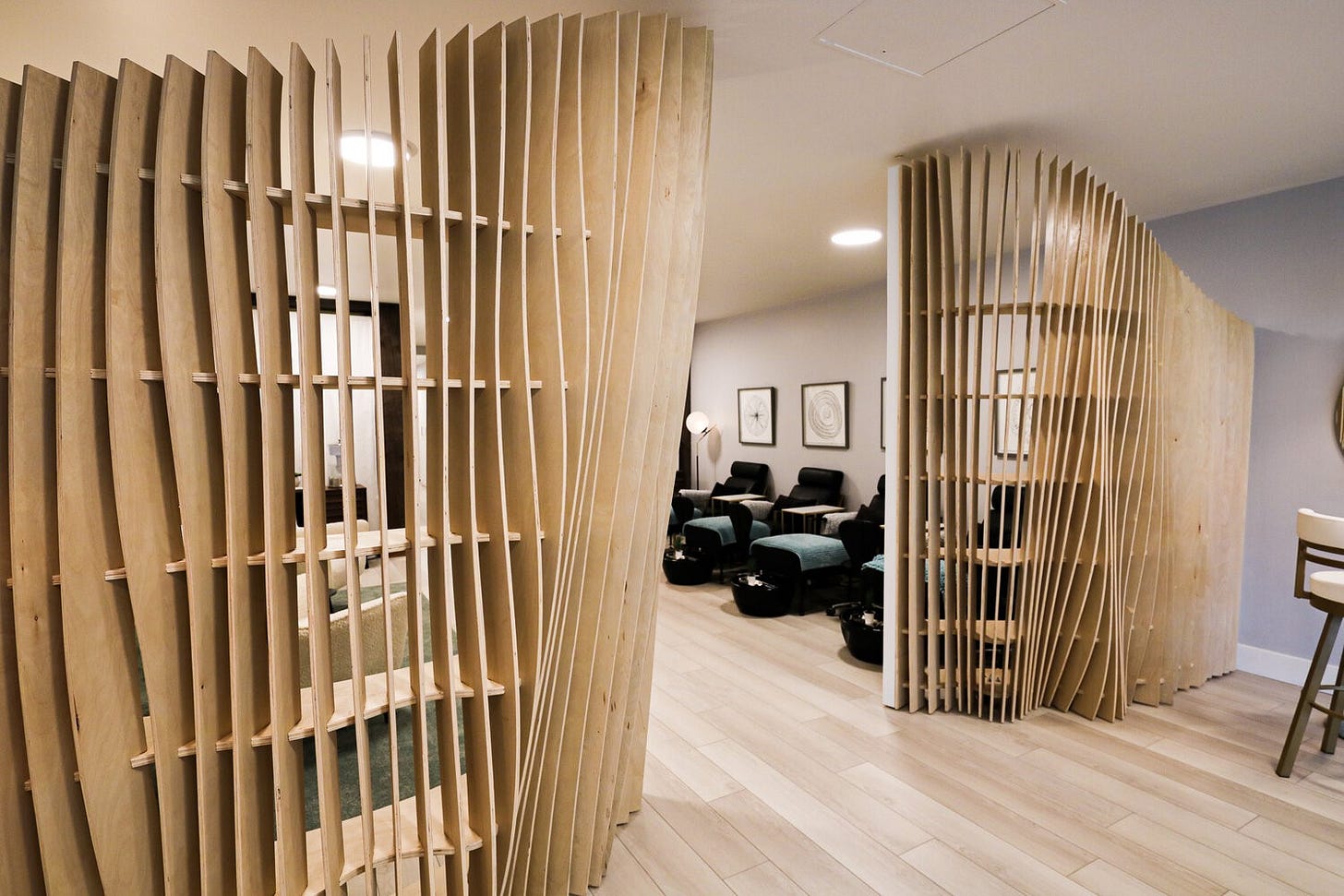
I don’t know whether or not Andrew and Tinka had been aware of the wood puzzles and other design applications that Jessica Rosenkrantz and Jessie Louis-Rosenberg were creating in the Catskills with the same parametric design methods through their company Nervous Systems, but they certainly have followed similar paths and possibly use the same software.
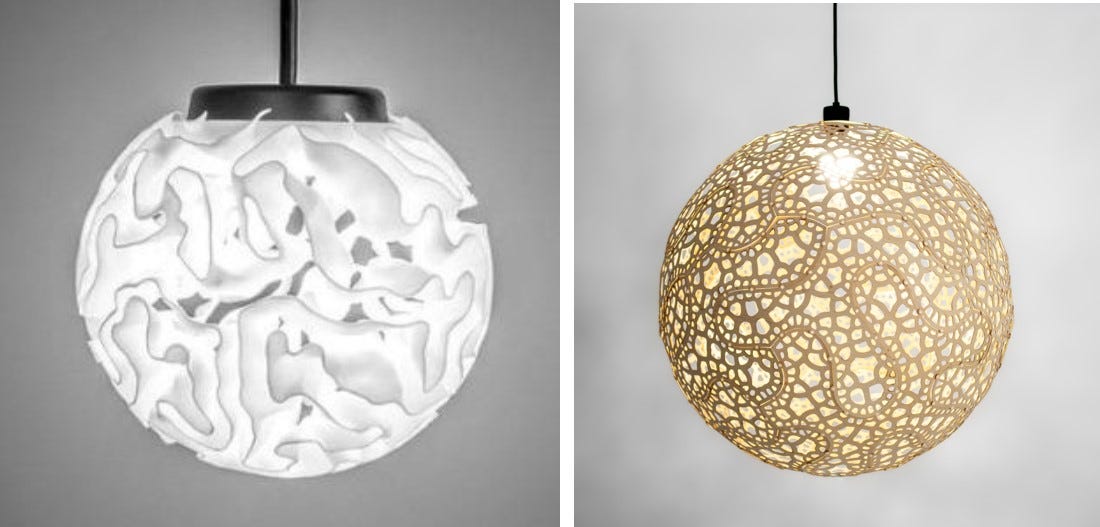
In a 2016 interview Andrew said: “We’re surrounded by materials and opportunities on the West Coast to break through the mundane and help people see things in a way they never have before. We want to change people’s perceptions of what’s possible.”
For four years Studio Robazzo was growing, both in reputation and in volume of business. Then came Covid-19.
As early as March 16, 2020, only five days after it was declared to be a pandemic, the team was advising their clients and other small businesses to conduct their meetings on Zoom and develop ways to offer their services and goods online. They advised that businesses should “transition to a total online life.”
The couple followed their own advice but soon realized, like so many of us, that non-stop screen time can be ____________. (fill in the blank) They felt it in their own lives, and they knew that others must be feeling the same way. By autumn of that year Tinka and Andrew had founded puzzle lab, one of many new laser-cut wood puzzle companies that were born at about the same time, from the same motivation.
According to Tinka in a March 2021 interview: “We were struck by how much time we were spending on our screens, especially since everything (meetings, hangouts, parties) went online due to the pandemic. The idea to make puzzles came from a desire to get people like ourselves off of our devices and into the real world.”
Puzzle lab seems to be very successful, and as far as I can tell Andrew and Tinka are now focussing most of their time on what they had expected to be a side gig for Studio Robazzo. As I understand it, they are continuing to provide services to their established SR clients but are no longer actively working to grow that side of their business.
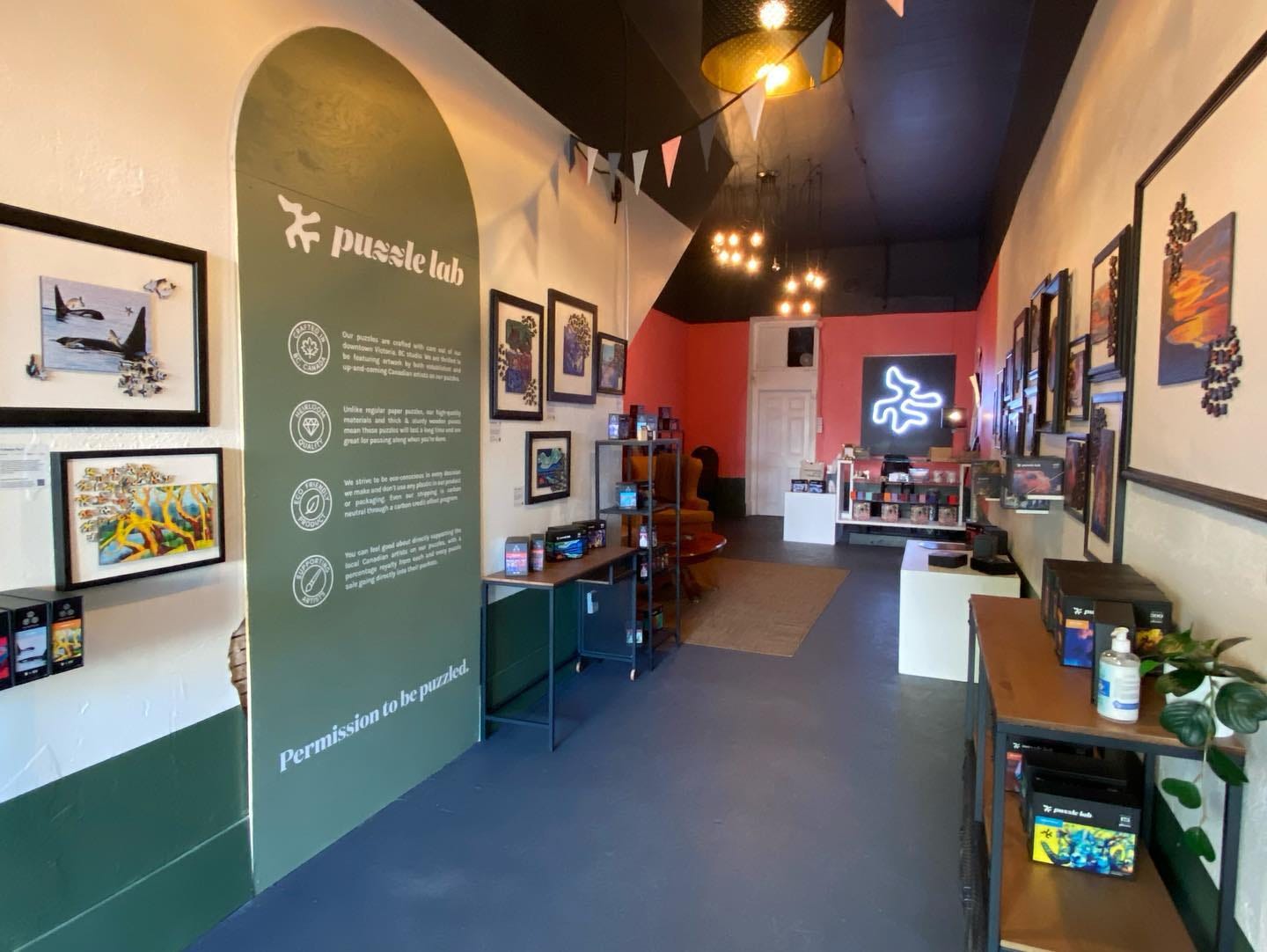
In just the past few months they have invested in a second laser cutting machine and a high-end UV printer, have opened a new store (designed to look like a puzzle art gallery) in the heart of the tourist area of Downtown Victoria, and they have hired more full-time and part-time staff to assist them in the workshop and the store.
The Artist

Ella Mazur is a Toronto-based artist and illustrator who works mainly in pen and ink. This is the second of her drawings that Puzzle Lab has used for a puzzle. The first one was Adventure Awaits.
Rather than me telling you about her I’ll let her do that. Along with a number of other interesting posts, in December of 2020 she wrote her own “artist origin story” on her blog. It begins:
When I was a little girl, I never thought I would grow up to be an artist. Although I loved arts and crafts and being creative, I didn’t draw all that much. But I was obsessed with stories. In fact, I grew up thinking that I'd become a writer. I always loved the idea of creating new worlds with my imagination. As it turned out, writing wasn’t the right medium for me. I still tell stories, and I still do it with a pen, but now I share my imagined dreamscapes with the world through drawings.
So how did I end up becoming a full-time artist and illustrator? Read on to learn about my journey, and about two transformational pieces that have shaped my illustration style! . . .
Epilogue digression about tigers
In areas where humans are nearby tigers are nocturnal hunters. But in remote locations they are diurnal – hunting during either day or night. They are solitary stalkers, relying on sight and sound rather than smell for hunting. Asian tigers can eat over 36 kilos (80 lbs) of meat at one time. Tigers are not the world’s largest predators, but in all of their ranges they are the top predators (if you don’t include us humans.) A male Asian tiger can grow to 300 kilos (660 lbs.)
On average, female tigers can give birth to two to four cubs at one time, and have a litter every two years.
Because they are such, dare I say, majestic animals they have long been the object of study by scientists. Beginning with Carl Linnaeus himself, the founder of taxonomy, scientists have measured tigers’ skulls and the length of their hair, and studied their colouration and stripe patterns, to identify many different current and now-extinct species and sub-species.
However in 2017, based on DNA analysis an international Cat Classification Task Force concluded that all of the tigers on the Asian continent, from Siberia and Korea to southern India and Malaysia, are all the same species and subspecies – Panthera tigris tigris. Their differences in appearance are really only minor variations cause by adaptation to new habitats and inbreeding within isolated populations. As you might guess, this decision has been controversial among taxonomists and is still in dispute.
Under this new taxonomy there is only one other subspecies – much smaller tigers that evolved on Indonesian islands that have long been separated from the mainland. Of these, the Sumatran tiger is the only surviving population, and they are critically endangered with only about 50 animals still in the wild.
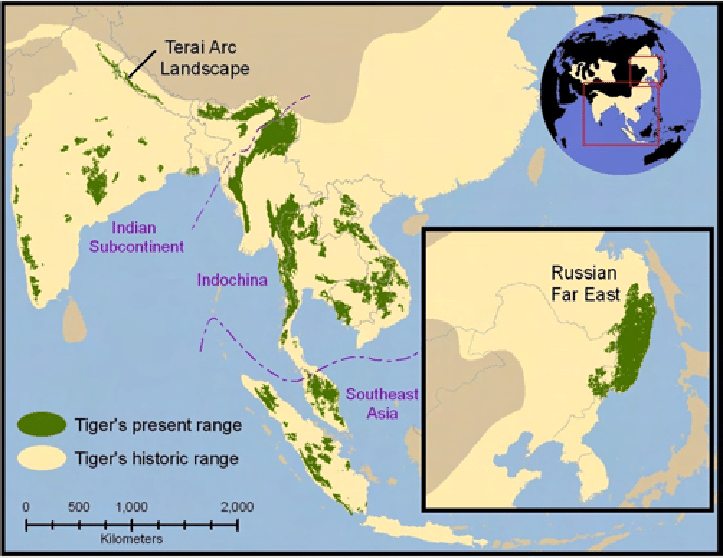
An estimated 4000 tigers still live in the wild in Asia. After a century of decline, through habitat protection and other conservation measures the wild population in Asia is now starting to grow in numbers. However further work is needed to conserve habitat, stabilize the population, and to reintroduce captive regional variations that have become locally extinct in the wild back into suitable places where they will not be a threat to people or subject to poaching.
If you want to support their conservation there are many organizations that have an online presence and need financial assistance for their work. One of them is the World Wildlife Fund.

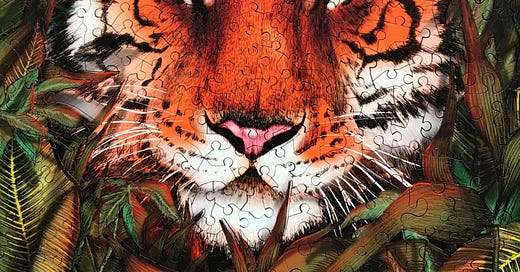



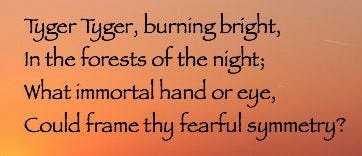
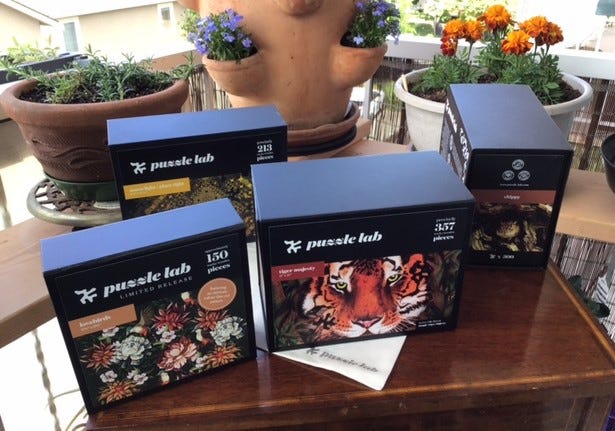
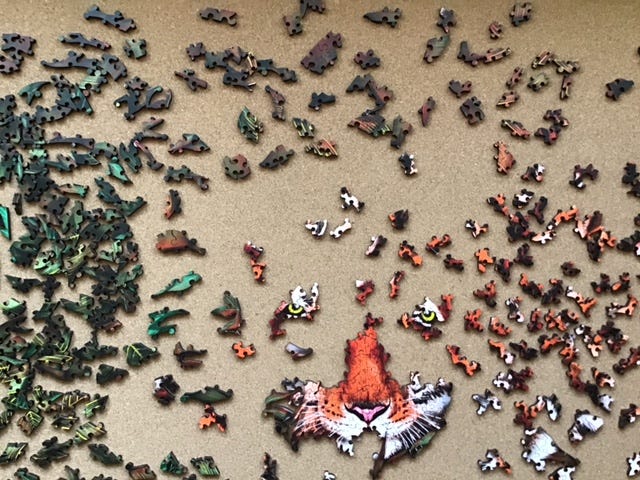
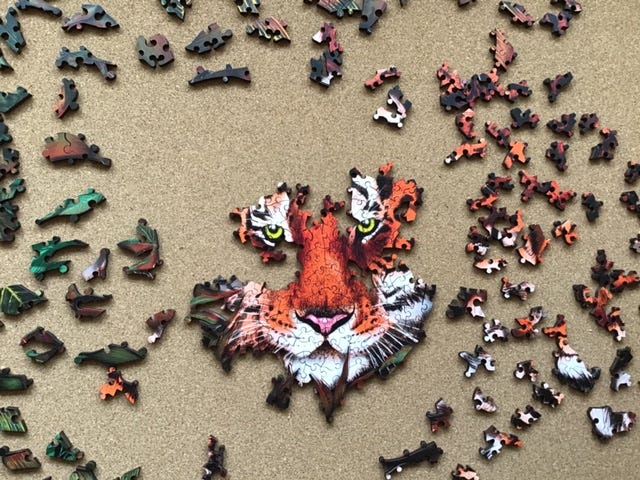
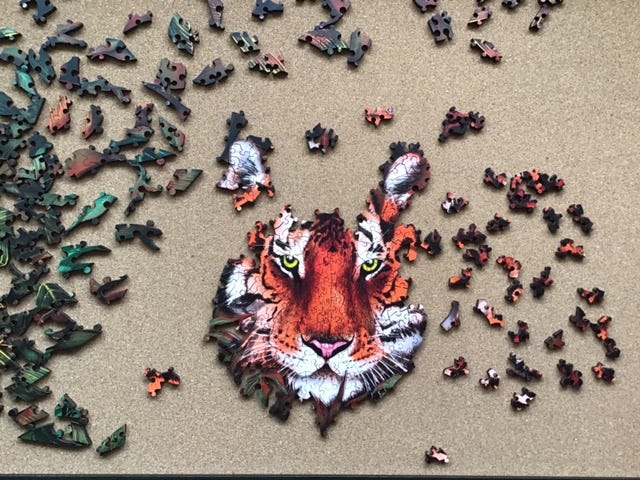
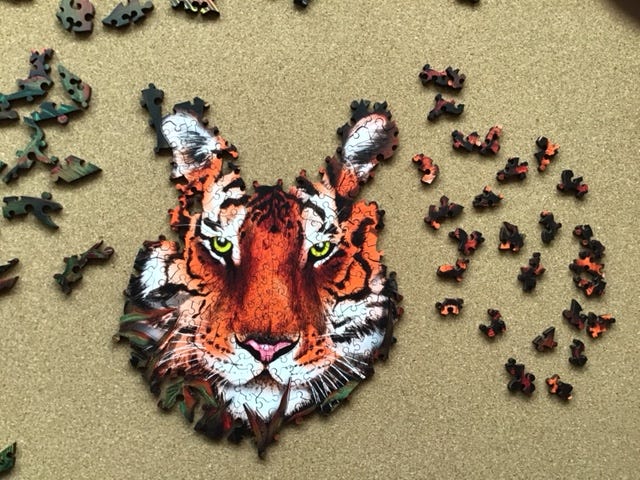
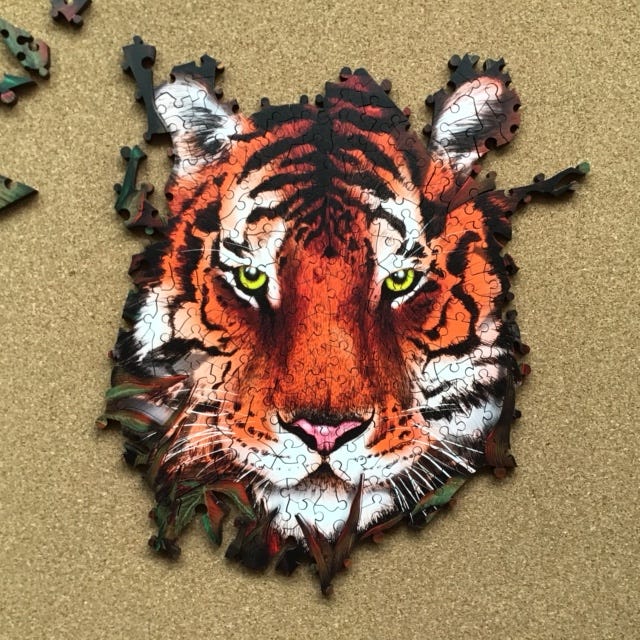
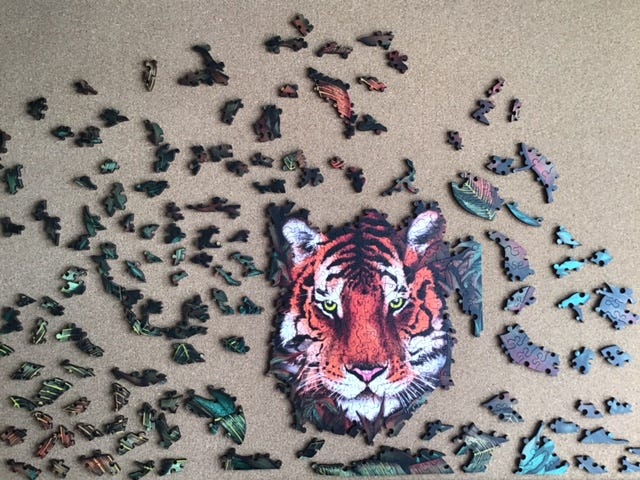
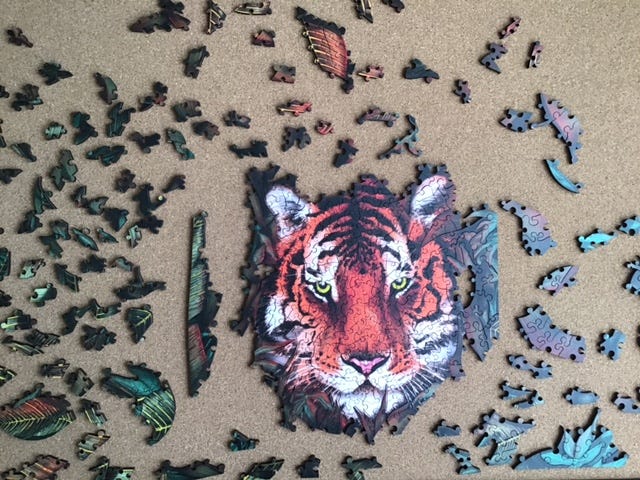
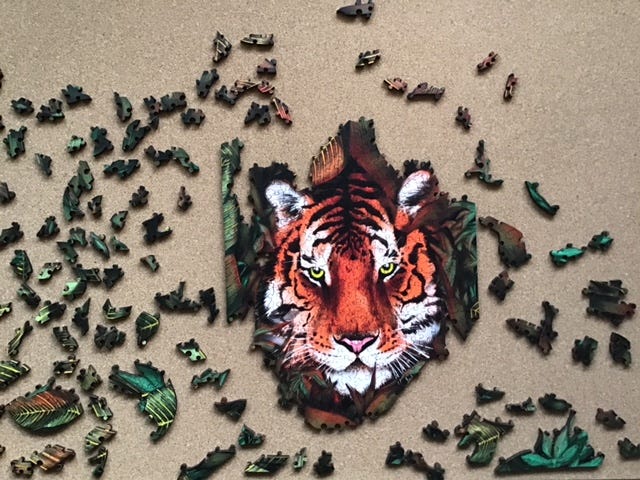
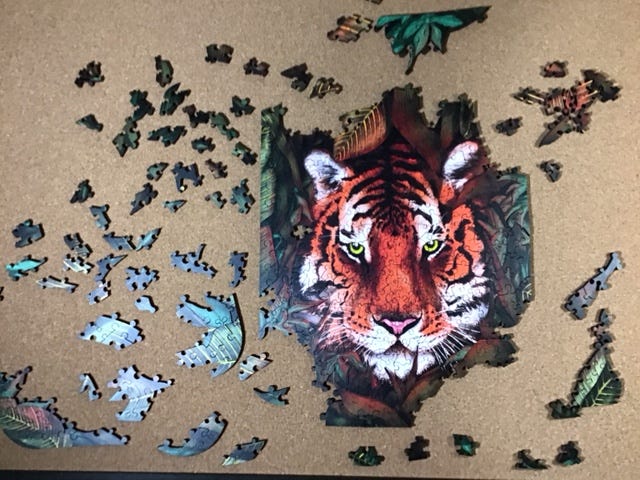
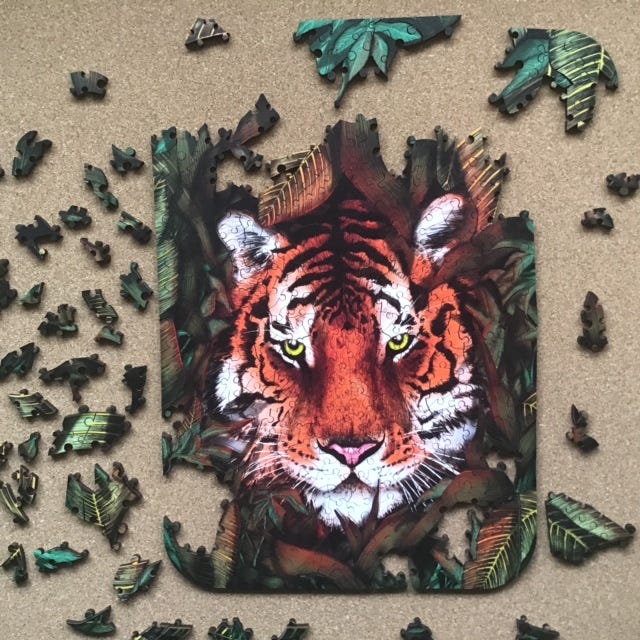
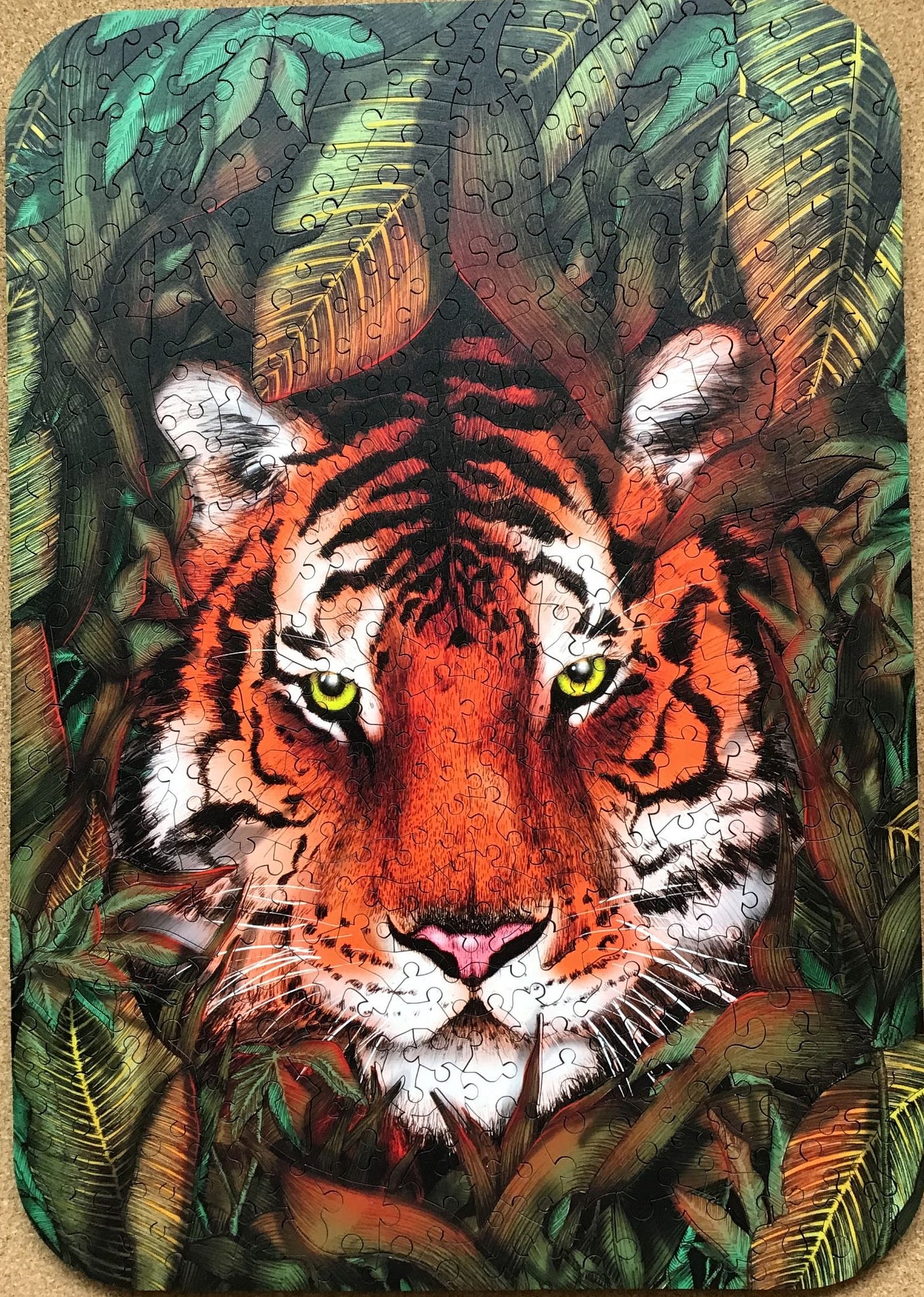
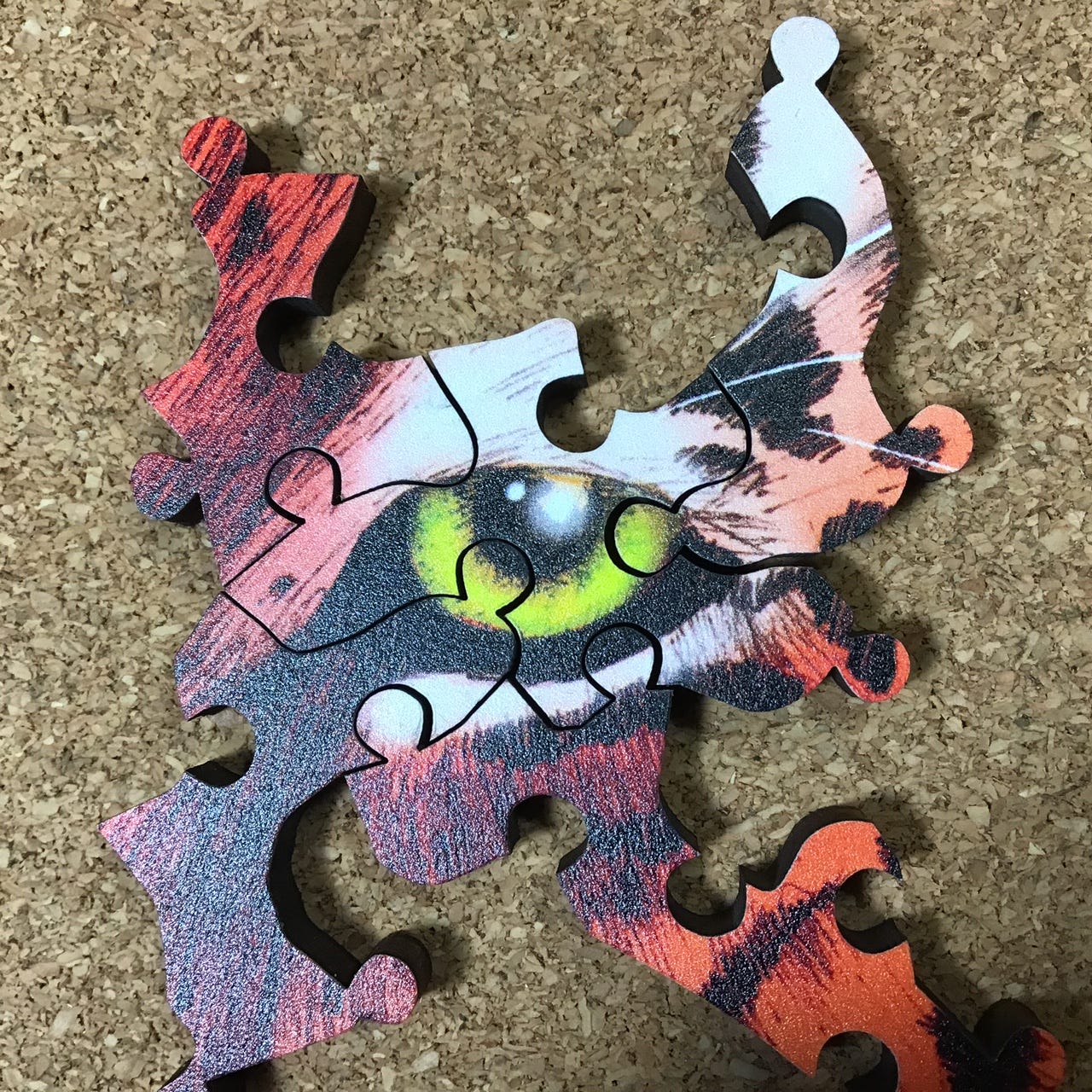

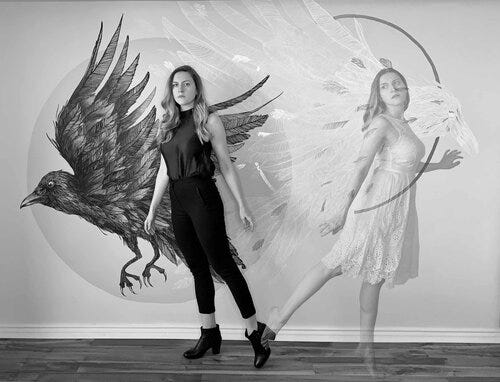
Nice write-up Bill. Loved the info on the owners. I tell you the picture of their puzzle gallery/shop threw me for a loop, I thought that the one on the wall, Arbutus #1 had a tree top that came out of the upper left side at first, and I was like "I must buy that immediately!", and then looked closer and saw that was their creativeness showing off the unbuilt corner... aww shucks. I've talked myself out of that one several times, I like it, but I want it to be more. That would have been the more I was hoping for. Fun to see the creative ways they display their puzzles though, obviously creative artistic minds. :) Thanks for the fun write-up. :) I think you're pretty skilled if you handled the connectors all being the same in this Tiger puzzle... that's a challenge for sure.
I have several thoughts about your latest posting re: the tiger puzzle. First, I have been a fan of William Blake's poetry for over 60 years. Also, I am heartened by the news that at least some varieties of these beautiful animals (tigers) seem to be increasing their numbers and heading in the opposite direction re: possible extinction. Also, I get a kick out of the background story re: the startup of Studio Robazzo (Rob + azzo) and am glad that they are into varied aspects of design. Lastly, I consider Ella Mazur's artwork for today's featured puzzle to be excellent.